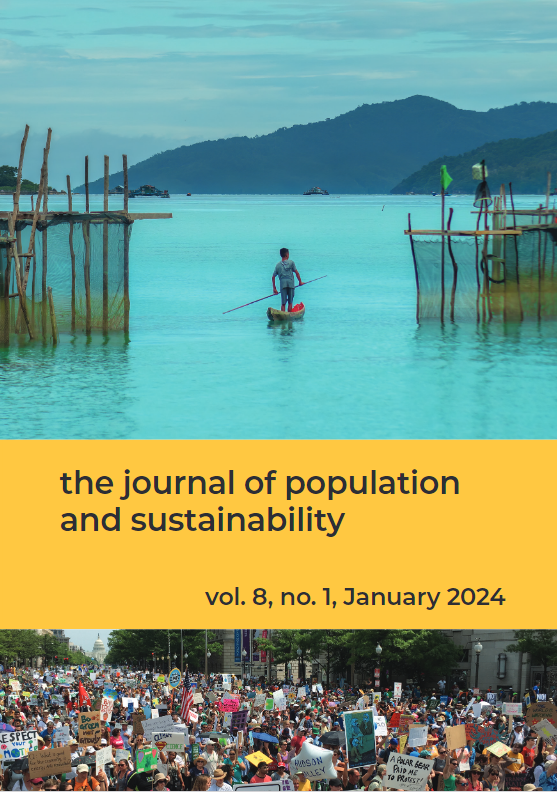
Thoughts on declining fertility and scientists’ warning
The Journal of Population and Sustainability, published by White Horse Press, explores all aspects of the relationship between human numbers and environmental issues.
Population is a complex, multifaceted subject, one that is often neglected and misunderstood in the wider world. We know that population numbers have a significant impact on planetary health and its inhabitants, so there is a real need for high-quality studies that investigate at these issues.
This is where the Journal of Population & Sustainability (JP&S) comes in. The JP&S is where to go for the latest trends, academic research and in-depth analysis for those who want to understand the issues more comprehensively. The bi-annual journal publishes peer-reviewed and invited material and is edited by David Samways, whose research interests centre around socio-technical practices and environmental sustainability.
While financially supported by Population Matters, the JP&S is editorially independent and welcomes contributions from a variety of perspectives on the role of population in environmental problems. The views and opinions expressed by authors do not necessarily reflect those of the editor, the editorial board or publisher.
The most recent edition was published in January this year – please read on for a brief summary of what’s inside.

An introduction
David Samways opens the latest volume of the JP&S referencing COP28, which took place at the end of last year in the UAE. It was another international meeting that was met with scepticism and was defined by underwhelming commitments amid a nonsensical backdrop. David points out that, although population is undoubtedly an indirect driver of our the environmental crisis, it is not considered within the COP framework.
While the level of consumption, especially of the most affluent, is cited as the most significant factor in the generation of the environmental crisis, population growth is universally acknowledged in the scientific literature as a significant indirect driver of present and future trends.”
Public Opinions about Causes of Declining Fertility in Developing Countries
The first article is by Frank Götmark and Nordhild Wetzler, two Swedish academics. Their premise is that though the causes of declining total fertility rates have been studied and identified, little research has been done into what people think about why it happens. The authors have compared the public perception from educated citizens in a developed country (Sweden) and a developing country (Nigeria), asking why the birth rate has fallen in a developing country (Nigeria).
In Sweden, 72 per cent of respondents suggested improved living conditions, including economy and education, lower infant mortality and generally progressive development. In contrast, in Nigeria 66 per cent of the respondents suggested that poverty, bad socioeconomic conditions and poor health cause declining birth rates.”
Socio-ecological drivers of the pastoralist-farmer conflict
The second paper is by Chukwudi Njoku, Joel Efiong and Stefano Moncada. Their contribution examines the conflicts between pastoralists and settled farmers in the Mid-Benue Trough in central Nigeria, illustrating the complexity of the interactions of demographic factors, environmental change, socio-economic conditions and cultural factors.
This study introduces the ethnicity dimension alongside factors such as climate change, economic development, population density, political violence and terrorism. Data originates from secondary sources, and multinomial regression is used to model significant effects.”
Contemporary extinctions and multispecies thanatopolitics
This third peer-reviewed article is by Portuguese academic João Aldeia. Michael Foucault was a French philosopher and writer, and Aldeia argues that, contrary to Foucalt’s position, modern biopolitics is inherently thanatopolitical (or politics of life premised on a politics of death).
In modernity, biopolitical interventions in what Foucault defines as the milieu are intended to foster the lives of (certain) human populations, while they are also premised on killing non-human species.”
Scientists’ warning on the impacts of population on living systems
The final article comes from Dr. M. Lynn Lamoreux and Prof. Dorothy C. Bennett. They note that our obsession with endless growth for profit, which includes population growth, is at odds with the function of the biosystem; the two are not compatible.
The function of the biosystem and its components is the sustainable reproduction and evolution of life. Humans have many of their own systems, including a global, commercially oriented system of corporations and social structures, which we term the corposystem. A major aim of the corposystem is endless growth for profit, which depends on endless human population growth: not sustainable on a finite planet.”
The latest JP&S is the 14th edition, and if you’d like to delve into the archive you can see all previous versions here. Finally, if you’d like to receive the JP&S directly into your inbox twice a year upon its publication, please let us know.



